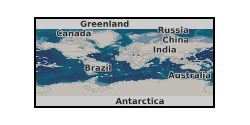Impact structures
Type of resources
Topics
Keywords
Contact for the resource
Provided by
Years
Formats
Update frequencies
-

The data within this repository contains results from IODP-ICDP Expedition 364 which drilled the Peak Ring of the Chicxulub Crater, offshore Mexico. The offshore phase of this expedition occurred in April-May 2016, while the onshore phase occurred in October 2016. Further details of the IODP expedition can be found in the expedition report (https://doi.org/10.14379/iodp.proc.364.2017). The data within the repository is sorted into 4 separate folders: 1 - Optical_Images 2 - SEM_Image_Processing 3 - UStage 4 - Numerical_Models 1 - Optical_Images This folder contains two sub-folders: Optical_WholeSection, which contains whole thin-section plane- and cross-polarised stitched images of thin sections from Hole M0077A, acquired using a Zeiss optical microscope at 4x magnification at Curtin Univesity, Perth. Section names follow IODP standard sample naming convention. Optical_Photos, which contains sub-sub-folders delimiting samples, each of which contains individual images of features of interest in thin sections from Hole M0077A, magnification and a brief description of the feature are indicated by the file name and scale bars are provided on the image. 2 - SEM_Image_Processing This folder contains 10 sub-folders, specific to the individual analysed section. Each sub-folder contains a whole thin-section Back-Scattered Electron (BSE) Scanning Electron Microscope (SEM) stitched tiff image with a pixel width of 750nm. Data was acquired using a Zeiss Ultra Plus SEM at the NHM London. The images were then processed to analyse pore spaces within the thin sections. All folders contain a text file called “TOTAL.txt” which records data from every pore within the thin section. If the thin section contained any cataclasite bodies, two additional text files “CATACLASITE.txt” and “CATACLASITE_TOTALAREA.txt” can be found, the former contains the pore analysis of the selected cataclasite area, the latter indicates the size of the selected cataclasite area. All image analysis was carried out using the ImageJ software package. 3 - UStage This folder contains one .xlsx file that summarises the results of universal-stage optical microscope analysis of quartz planar deformation features of thin sections within hole M0077A. 4 - Numerical Models This folder contains 5 text files. “asteroid.inp” and “material.inp” are the input model parameters of the iSALE shock physics code (http://www.isale-code.de/redmine/projects/isale), these inputs were used to model the Chicxulub impact. Post-processing of the data was achieved using python to track the Stress-Strain-time paths of peak ring material, the remaining three .txt files contain the results of that analysis at different temporal resolutions.
-

Cell count data from the Chicxulub crater. Grant abstract: The deep subsurface is recognised to be an environment that supports a large and diverse microbial biosphere, and yet we still know very little about how microorganisms grow in this environment, what their spatial diversity is and how this diversity is controlled by subsurface geochemical conditions. Previous research has primarily focused on deep-ocean sediments. Work in these environments has shown that geochemical interfaces are important for determining the diversity of the subsurface biosphere. Little is known about how the subsurface biosphere in marine environments compares to that in continental subsurface environments. Our laboratory will acquire core samples collected from the peak ring of the 66 million-year old Chicxulub impact structure buried beneath the Gulf of Mexico in April-May 2016 during IODP Expedition 364. This end-Cretaceous impact structure is hypothesised to have been responsible for causing the extinction of the dinosaurs and ~75% of all other life at this time. The drill core will be retrieved with microbiological contamination control to ~1.5 km depth. Thus, the drill core offers the opportunity to investigate the subsurface microbiology of a continental site and also how the microbial diversity relates to a unique, but well-defined subsurface lithologic sequence. In this project we propose to use these cores to gain new insights into the diversity of microorganisms in the subsurface. In this project we will: 1) Quantify the biomass of microorganisms through the core and correlate it to the lithologies to understand how microbial life in the continental deep subsurface is influenced by lithology, 2) Specifically investigate how microbial abundance and diversity is correlated to impact lithologies to understand how impacts can disrupt the deep subsurface biosphere, 3) Culture and use '-omics' methods such as metagenomics to understand how the functional capabilities and metabolisms of organisms correlate to the environment and lithology through the core to gain a better understanding of microbial biogeochemical processes in the deep subsurface in general and specifically in an impact crater, 4) Use the above data to understand more generally how life recolonises impact craters and how craters might provide a habitat for life despite otherwise catastrophic effects on large surface dwelling life.
 NERC Data Catalogue Service
NERC Data Catalogue Service